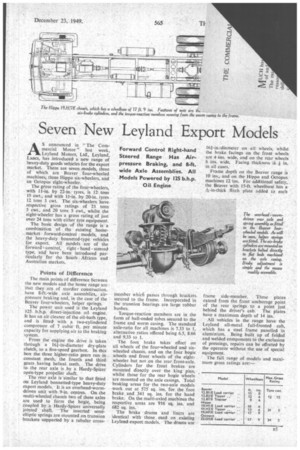Seven New Leyland Export Models
Page 39

If you've noticed an error in this article please click here to report it so we can fix it.
AS announced in "The Commercial Motor" last week, Leyland Motors, Ltd, Leyland, Lanes, has introduced a new range of heavy-duty goods vehicles for the export market. There are seven models, three of which are Beaver four-wheeled machines three Hippo six-wheelers, and an Octopus eight-wheeler.
The gross rating of the four-wheelers, with 11-in. by 22-in. tyres, is 12 tons 1-5 cwt., and with 13-in. by 20-in. tyres 12 tons 3 cwt. The six-wheelers have respective gross ratings of 21 tons 5 cwt., and 20 tons 5 cwt., whilst the eight-wheeler has a gross rating, of just over 24 tons with either tyre equipment.
The basic design of the range is a combination of the existing homemarket forward-control . models, and the heavy-duty bonneted-type vehicles for export. All models are of the forward control, right hand steered type, and have been introduced particularly for the South African and Australian markets.
Points of Difference
The main points of difference between the new models and the home range are that they are of sturdier construction, have 8-ft.-wide axle assemblies, airpressure braking and, in the case of the Beaver four-wheelers, helper springs.
The power unit used is the Leyland 1.25 b.h.p direct-injection oil engine. It has an air cleaner of the oil-bath type, and is fitted with a two-cylindered compressor of 7 cubic ft, per minute capacity for supplying air to the braking system.
From the engine the drive is taken through a 161-in-diameter dry-plate clutch, to a five-speed gearbox. In this box the three higher-ratio gears run in constant mesh, the fourth and third gears having helical teeth. .The drive to the rear axle is by a Hardy-Spicer open-type propeller shaft.
The rear axle is similar to that fitted ort Leyland bonnetted-type heavy-duty export models. It is an overhead-wormdriven unit with 9-in. centres. On the multi-wheeled chassis two of these axles are used to form the bogie, being coupled by a Hardy-Spicer universally jointed shaft. The inverted semielliptic springs are mounted on. trunnion brackets supported by a tubular cross member whicci passes through brackets secured to the frame. Incorporated in the trunnion bearings are large rubber bushes.
Torque-reaction members are in the form of ball-ended tubes secured to the frame and worm casing. The standard axle-ratio for all machines is 7.33 to 1, alternative ratios offered being 6.5, 8.66 and 9.33 to I.
The foot brake takes effect on all wheels of the four-wheeled and sixwheeled chassis, and on the four bogie wheels and front wheels of the eightwheeler but not on the rear front-axle. Cylinders for the front brakes are mounted directly over the king pins, whilst those for the rear bogie wheels are mounted on the axle casings. Total braking areas for the two-axle models work out at 575 sq. ins, for the foot brake and 341 sq, ins, for the hand brake. On the multi-axkd machines the respective areas are 916 sq. ins. and 682 sq. ins.
The brake drums and liners are identical with those Used on existing Leyland export models. The drums are 16i-in.-diameter on all wheels, whilst the brake facings on the front wheels are 4 ins, wide, and on the rear wheels 6 ins. wide. Facing thickness i§ tn. in all cases.
Frame depth on the Beaver range is 10 ins., and on the Hippo and Octopus machines 12 ins. For additional safety, the Beaver with 15-ft. wheelbase has a -P-6-in-thick flitch plate added to each
frame side-member. These plates extend from the front anchorage point of the rear springs to a point just behind the driver's cab. The plates have a maximum depth of 14 ins.
All vehicles in the range have, the Leyland all-metal full-fronted cab, which has a steel frame panelled in aluminium. Being built up of folded and welded components to the exclusion of pressings, repairs can be effected by the operator without the use of special equipment. The fall range of models and maximum gross ratings are:— •




















































































